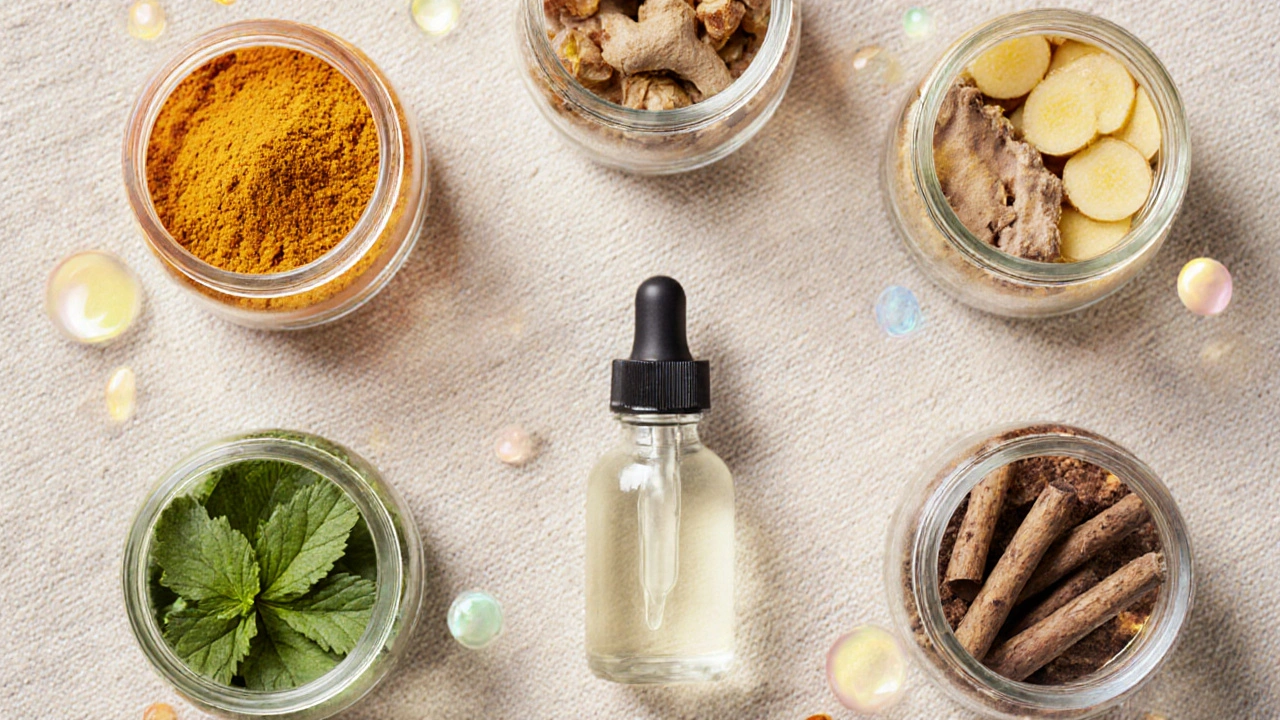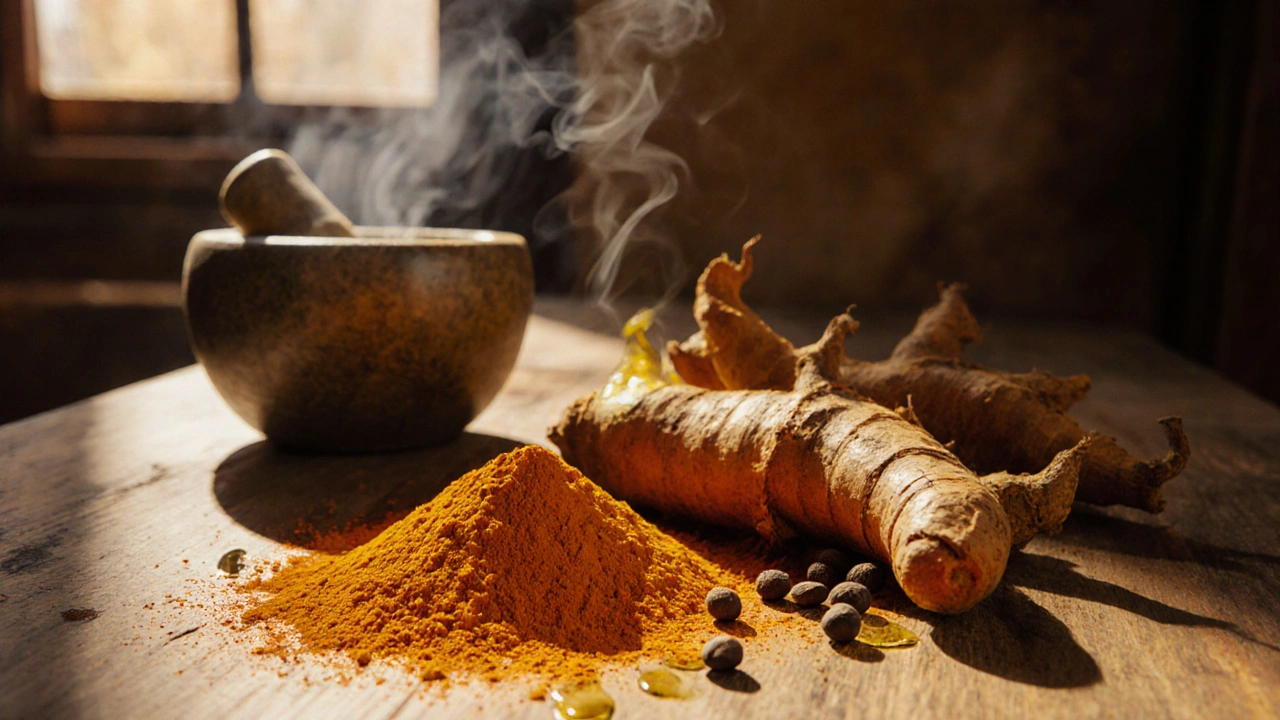Haridra vs Alternatives Comparison Tool
Comparison Results
Select an herb and goal to see detailed comparison information.
Quick Recommendations
Based on your selection:
- Review the key active compounds and bioavailability factors.
- Check for potential interactions with medications or health conditions.
- Consider combining with other herbs for synergistic effects.
Looking for a natural way to calm inflammation, support digestion, or boost joint health? You’ve probably heard of Haridra, the bright‑yellow spice that’s been used for centuries in Ayurvedic medicine. But the market is flooded with other herbs and extracts that claim similar benefits. This article breaks down Haridra’s strengths, weaknesses, and how it stacks up against the most popular alternatives so you can decide what fits your routine best.
Key Takeaways
- Haridra’s active component, curcumin, is a potent anti‑inflammatory, but its low natural bioavailability means you often need an enhancer like black pepper.
- Boswellia excels for joint pain with a higher absorption rate, while ginger is gentler on the stomach and great for nausea.
- Ashwagandha offers stress‑relief benefits that Haridra lacks, making it a better choice if anxiety is a primary concern.
- CBD oil provides a broad spectrum of cannabinoids that can complement Haridra for chronic pain, but legal status varies by region.
- When safety is paramount, neem and licorice have well‑documented safety profiles at standard doses, whereas high‑dose Haridra may irritate the gallbladder.
What Is Haridra?
Haridra is a common name for the rhizome of Curcuma longa, a plant native to South Asia. Known in the West as turmeric, Haridra has been a staple in Ayurvedic formulations for over 4,000 years. Its vivid orange hue comes from a group of polyphenols called curcumin, which are responsible for most of its anti‑inflammatory and antioxidant actions.
How Haridra Works
Curcumin interferes with several inflammatory pathways, most notably by inhibiting the NF‑κB transcription factor. This reduces the production of cytokines like TNF‑α and interleukin‑6. Curcumin also scavenges free radicals, helping protect cells from oxidative damage. However, curcumin’s molecular size and rapid metabolism mean less than 5% is absorbed when taken alone. That’s why many formulations pair Haridra with piperine (the active component of black pepper) or use phospholipid‑based delivery systems to boost bioavailability.
Popular Alternatives at a Glance
Below are the most cited herbal options that people compare with Haridra. Each has its own active compounds, typical uses, and safety considerations.
- Boswellia - resin from the Boswellia serrata tree; contains boswellic acids that target inflammation in joints.
- Ginger - rhizome of Zingiber officinale; rich in gingerols that ease nausea and mild inflammation.
- Ashwagandha - root of Withania somnifera; withanolides help lower cortisol and improve stress resilience.
- CBD oil - extract from Cannabis sativa; interacts with the endocannabinoid system to modulate pain and anxiety.
- Neem - leaves of Azadirachta indica; known for antimicrobial and blood‑sugar‑regulating properties.
- Licorice - root of Glycyrrhiza glabra; contains glycyrrhizin, useful for soothing digestive irritation.

Side‑by‑Side Comparison
| Herb | Key Active Compound(s) | Anti‑inflammatory Strength* | Bioavailability (Typical) | Common Daily Dose | Safety / Notable Side Effects |
|---|---|---|---|---|---|
| Haridra | Curcumin (2‑3% curcuminoids) | High (when boosted) | Low - 5% without piperine; 20‑30% with piperine | 500‑2000mg curcumin extract | Generally safe; may irritate gallbladder, interacts with anticoagulants |
| Boswellia | Boswellic acids | Moderate‑High | Medium - 30‑40% | 300‑1000mg standardized extract | Rare GI upset; avoid in severe liver disease |
| Ginger | Gingerols, shogaols | Low‑Moderate | Medium - 25‑35% | 1‑2g fresh or 500mg powdered | Heartburn in high doses; may thin blood |
| Ashwagandha | Withanolides | Low (primarily adaptogenic) | Medium - 30‑40% | 300‑600mg extract | Possible thyroid stimulation; avoid during pregnancy |
| CBD oil | Cannabidiol (CBD) | Moderate‑High (via endocannabinoid modulation) | High - 70‑90% sublingual | 10‑30mg CBD | Dry mouth, drowsiness; legal restrictions in some regions |
| Neem | Azadirachtin, nimbidin | Low‑Moderate | Low - 10‑15% | 300‑600mg leaf extract | Potential liver enzyme induction; not for children |
| Licorice | Glycyrrhizin | Low (mainly soothing) | Medium - 30‑35% | 0.5‑1g deglycyrrhizinated extract | Can raise blood pressure; avoid long‑term high doses |
*Strength rating is based on peer‑reviewed studies measuring reduction in cytokine levels and patient‑reported pain scores.
When Haridra Shines
If your primary goal is to target systemic inflammation-think arthritis, chronic skin conditions, or metabolic inflammation-Haridra is hard to beat, especially in a formulation that includes piperine. The combination can achieve up to a six‑fold increase in plasma curcumin levels, which translates to noticeable relief for many users within 4‑6 weeks.
Haridra also doubles as a culinary spice, meaning you can integrate it into daily meals without adding a separate supplement. Adding a teaspoon of ground Haridra to smoothies, soups, or golden milk provides a gentle, continuous dose of antioxidants.
When Alternatives Might Be a Better Fit
- Joint‑specific pain: Boswellia’s boswellic acids stay longer in joint tissue, making it a go‑to for osteoarthritis.
- Nausea or digestive upset: Ginger’s rapid gastric emptying action works faster than Haridra’s systemic approach.
- Stress and sleep: Ashwagandha’s cortisol‑lowering effect can improve sleep quality, something Haridra doesn’t directly address.
- Chronic neuropathic pain: CBD oil engages cannabinoid receptors that Haridra does not, often delivering stronger analgesia for nerve‑related pain.
- Blood‑sugar regulation: Neem has modest hypoglycemic properties, useful for pre‑diabetic individuals.
Choosing the Right Form and Dosage
- Standardized extracts: Look for labels that list % curcumin (e.g., 95% curcuminoids) and include piperine. This ensures you’re getting a potent, absorbable product.
- Whole‑food powders: If you prefer food‑based intake, choose high‑quality, organic Haridra powder without fillers. Pair it with a fat source-olive oil, coconut milk, or avocado-to aid absorption.
- Capsules vs. liquids: Capsules protect curcumin from heat degradation, while liquid tinctures can be mixed into drinks for quicker uptake.
- Stacking strategies: Combine Haridra with black pepper (5mg piperine) or with phosphatidylcholine (as in “Meriva” complexes) to boost bioavailability. Some users also stack with Boswellia for joint‑focused protocols.
- Cycle timing: Because high doses can irritate the gallbladder, many practitioners suggest a 4‑week on, 1‑week off cycle, especially if you have a history of gallstones.

Potential Pitfalls and Interactions
Haridra is generally safe for most adults, but there are a few red flags. Its blood‑thinning effect can amplify the action of anticoagulants like warfarin or aspirin, raising bleeding risk. People with gallbladder disease should avoid high‑dose extracts because curcumin can stimulate bile flow, potentially worsening symptoms. Pregnant or breastfeeding women are advised to stick to culinary amounts only, as high therapeutic doses haven’t been studied extensively in these populations.
When mixing Haridra with other herbs, watch for overlapping actions. For example, combining Haridra with high‑dose ginger could increase the risk of stomach irritation, while stacking with multiple blood‑thinners (e.g., fish oil, garlic) may amplify anticoagulant effects.
Quick Decision Guide
Use the following flow to decide if Haridra is the right pick for you:
- Do you need strong anti‑inflammatory support?
Yes → Consider Haridra with piperine or a boswellia‑Haridra combo. - Is your primary issue digestive nausea?
Yes → Favor ginger or mint instead of Haridra. - Are you looking for stress‑relief or sleep aid?
Yes → Ashwagandha or valerian may be more effective. - Do you have a known gallbladder or liver condition?
Yes → Avoid high‑dose Haridra; try neem or licorice with caution. - Is legal access to CBD easy in your area?
Yes → CBD oil can complement Haridra for chronic pain.
Next Steps & Troubleshooting
If you start a Haridra regimen and notice no improvement after 6 weeks, try these adjustments:
- Switch to a bioenhanced formula (e.g., curcumin‑phytosome).
- Add a small dose of black pepper (5‑10mg piperine) to each serving.
- Combine with a fatty meal to improve absorption.
- Evaluate dosage-most studies show 500mg curcumin twice daily as the sweet spot.
- Consider rotating with Boswellia for a few weeks to target joint tissue directly.
Always track symptoms, dosage, and any side effects in a simple journal. If you experience stomach pain, rash, or unusual bruising, pause the supplement and consult a healthcare professional.
Frequently Asked Questions
Can I take Haridra with my blood‑thinning medication?
Haridra can enhance the effects of anticoagulants, raising bleeding risk. If you’re on warfarin, aspirin, or similar drugs, talk to your doctor before adding a therapeutic dose of Haridra. A low culinary amount is usually safe.
How does piperine improve curcumin absorption?
Piperine inhibits certain enzymes in the gut that would otherwise break down curcumin quickly. Studies show a 2000% increase in plasma curcumin levels when 5mg of piperine is taken with 500mg of curcumin.
Is Haridra safe for children?
Small culinary doses (a pinch in food) are generally fine. Therapeutic doses aren’t recommended for kids under 12 without medical supervision, as higher doses could affect liver enzymes.
What’s the difference between turmeric powder and a curcumin extract?
Turmeric powder contains about 2‑3% curcumin by weight and also includes fiber and other plant compounds. A curcumin extract is concentrated, often 95% curcuminoids, delivering a much higher dose in a smaller serving.
Can I combine Haridra with Boswellia?
Yes, many joint‑health formulas blend the two. Boswellia targets inflammation locally in the joint, while Haridra works systemically. Start with lower doses of each and monitor how you feel.

18 Comments
Joseph Bowman
I've been looking at the turmeric data for a while now, and it's hard not to notice the hidden agendas behind the supplement industry. They push Haridra as a miracle cure while quietly funding studies that hide the real side‑effects. The bioavailability tricks with piperine sound like a marketing gimmick designed to keep us buying more pills. If you peel back the layers, you'll see that many of the so‑called “clinical trials” are funded by the very companies that sell the product. Stay skeptical and double‑check the source of any claim before you swallow it.
Singh Bhinder
Interesting breakdown, the table makes it easy to compare strength and safety at a glance. I appreciate the note about gallbladder irritation with high‑dose Haridra, that's something many articles skip. The recommendation to pair it with a fatty meal is solid, as it really helps the curcumin get into the bloodstream. Overall, a balanced view that covers both pros and cons.
Kelly Diglio
Thank you for the comprehensive overview; the inclusion of both pharmacokinetic details and practical usage tips is valuable. The explanation of NF‑κB inhibition provides a clear mechanistic basis for the anti‑inflammatory claims. Highlighting the necessity of piperine or phospholipid complexes addresses a common source of user confusion. The safety section responsibly flags interactions with anticoagulants, which is essential for clinical awareness. I also like the suggestion to cycle Haridra to mitigate gallbladder concerns. The comparative table offers a quick reference that will aid practitioners in recommending alternatives. Your flowchart for decision‑making is intuitive and aligns with evidence‑based practice. This resource should serve both lay readers and health professionals alike.
Carmelita Smith
Haridra works well when paired with black pepper.
Liam Davis
The bioavailability boost from piperine is scientifically proven, and it's a simple addition, just 5 mg of piperine with 500 mg of curcumin, you’ll see a dramatic increase, in plasma levels, that translates to better outcomes, especially for chronic inflammation, 👍 keep an eye on dosage, and always pair with healthy fats for optimal absorption.
Arlene January
Honestly, I’ve tried the turmeric latte hack and it does make a difference, especially when I add a spoon of coconut oil. It’s a easy way to get the benefit without swallowing capsules.
Kaitlyn Duran
I noticed that many people skip the fat part, and that might be why they don’t feel the effects as strongly, adding avocado or olive oil seems to be the missing link.
Terri DeLuca-MacMahon
Great guide! 🌟 The side‑by‑side table is super handy, and I love the tip about rotating with Boswellia for joint support. Keep these updates coming! 😊
gary kennemer
From a pharmacological perspective, the curcumin‑phytosome complex offers a more consistent absorption profile compared to plain extract, which can be useful for patients who are sensitive to dosage fluctuations. It’s worth noting that the half‑life remains relatively short, so split dosing may improve steady‑state levels. Combining it with a modest amount of black pepper can further reduce inter‑individual variability. This approach aligns with the principle of using the lowest effective dose to achieve therapeutic benefit.
Payton Haynes
Be careful, big pharma doesn’t want you to know the real risks of high dose turmeric.
Earlene Kalman
This article glosses over the fact that many of these “studies” are funded by supplement giants, making the positives look bigger than they really are.
Brian Skehan
Looks good, but I’d still pick CBD for chronic pain over any spice.
Andrew J. Zak
CBD has its merits but it’s not a cure all and the legal gray area can be a hassle for some users.
Dominique Watson
While evaluating natural remedies, it is crucial to consider domestic agricultural practices and support locally sourced herbal products to maintain national health sovereignty.
Mia Michaelsen
In addition, the meta‑analyses on curcumin consistently show heterogeneity, so it’s important to interpret the pooled results with caution.
Kat Mudd
Reading through this comparison, I can’t help but see the pattern of hype that pervades the herbal supplement market, especially when the language used is full of buzzwords that sound impressive but often lack concrete backing, the claim that “Haridra is hard to beat” is repeated without sufficient acknowledgment of the variability in study designs, many of the cited trials have small sample sizes and are sponsored by companies that stand to profit from increased sales, furthermore the emphasis on piperine as a magic bullet ignores the fact that absorption can still be limited by individual gut microbiota differences, the safety section briefly mentions gallbladder irritation yet fails to discuss the long‑term impact of chronic high‑dose usage, readers should be aware that the interaction with anticoagulants is not a trivial warning, it can lead to serious bleeding events if not monitored closely, the recommendation to combine with Boswellia sounds appealing but the potential for additive gastrointestinal side effects is not explored, the article also does not address the environmental cost of mass‑producing turmeric, which involves intensive farming practices that can deplete soil nutrients, in contrast, some alternatives like neem have been studied for their lower ecological footprint, the table also simplifies bioavailability percentages which can be misleading because they are often derived from in‑vitro studies rather than real‑world absorption data, lastly, the decision guide is helpful but it assumes the reader has easy access to high‑quality extracts, which is not always the case for many consumers, therefore a more critical appraisal of the evidence and a balanced discussion of limitations would greatly strengthen this piece.
Pradeep kumar
Indeed, the pharmacodynamics of curcumin involve multiple signaling cascades, and the pharmacokinetic constraints you mentioned underscore the need for advanced delivery platforms like nano‑emulsions to achieve therapeutic plasma concentrations.
James Waltrip
One must recognize that the discourse surrounding phytochemicals has been unduly democratized, and only through a discerning, almost aristocratic, lens can we truly appreciate the nuanced interplay of molecular pathways that elevate Haridra above mere culinary garnish, especially when juxtaposed with the pedestrian profiles of ginger or licorice, whose mechanistic contributions are, frankly, lackluster in comparison to the elegant NF‑κB modulation exhibited by curcumin.